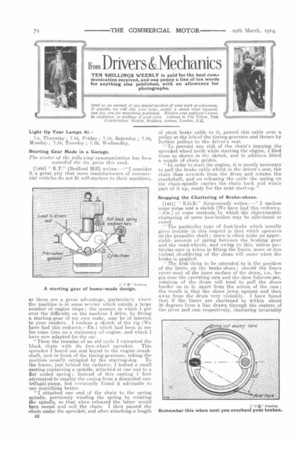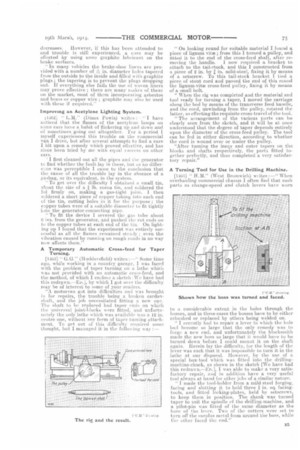From Drivers &Mechanics
Page 24

Page 25

If you've noticed an error in this article please click here to report it so we can fix it.
TEN SHILLINGS WEEKLY is paid for the best communication received, and one penny a line of ten words for anything else published, with an allowance for photographs.
_-----_
Send us an account of any sfecial incident of your work or exPerience. If suitable, we Win edit your MOMS. Sit PPly a sketch when required, and pay you for everything published. Mention your employer's name, in confidence, as evidence of good faith. Address to The Editor, Tifa COMMERCIAL MOTOR, Rosebery Avenue, London, E.G.
Light Up Your Lamps At – 7.8, Thursday ; 7.10, Friday ; 7.12, Saturday ; 7.16, Monday ; 7.18, Tuesday; 7.19, Wednesday.
Starting Gear Made in a Garage.
The sender of the following communication has been awarded the Ms. prize this week.
[1460] "R.T." (Bedford Hill) writes :—"I consider it a great pity that more manufacturers of commercial vehicles do not fit self-starters to their machines,
as these are a great advantage, particularly where the machine is in some service which entails a large number of engine stops ; the manner in which I got over the difficulty on the machine I drive, by fitting a starting-gear of my own make, may be of interest to your readers. I enclose a sketch of the rig [We have had this redrawn.—ED.] which had been in use for some time on a stationary oil engine, and which 1 ha.Ve now adapted for the car.
"From the remains of an old cycle I extracted the block chain with its free-wheel sprocket. This .sprocket I bored out and keyed to the engine crankshaft, just in front of the timing-gearcase, taking the
position usually occupied by the starting-dog. To the frame, just behind the radiator, I bolted a small casting containing a spindle, attached at one end to a fiat coiled spring; instead of this casting I first attempted to employ the casing from a discarded centrifugal-pump, but eventually found it advisable te use something better.
"I attached one end of the chain to the spring spindle, previously winding the spring by rotating the spindle, so that when released the latter would tarn round and coil the chain. I then passed the Phain under the sprocket, and after attaching a length
of stout brake cable to it, passed this cable over a, pulley at the leftaif the timing-gearcase and thence by further pulleys to the driver's seat.
" To prevent any risk of the chain's jumping the sprocket-wheel teeth while starting the engine, I filed them as shown in tbg sketch, and in addition fitted a couple of .chain guides. " In order to start the engine, it is merely necessary to pull the brake cable whilst in the driver's seat, the chain theta unwinds from the drum and rotates the crankshaft, and on releasing the cable the spring on the chain-spindle carries the chain back and 'winds part of it up, ready for the next start-up."' Stopping the Chattering of Brake-shoes.
[1461] " E.G.R." (Gravesend) writes I enclose
some notes and a slieteli [We have had this redrawn. —ED.] of some methods by which the objectivaable chattering of scune foot-brakes may be alleviated or cured.
" The particular type of foot-brake which usually gives trouble in this respect is that which operates on the propeller shalt; there is often quite an appreciable amount of spring between the braking gear and the road-wheels, and owing to this, unlesa particular care is token in fitting the liners, more or less violent shuddering of the shoes will occur when the brake is applied. " The first thing to be attended to is the position of the liners on the brake-shoes ; should the lineis cover most of the inner surface of the drum, i.e., begin near the eperating cam and the shoe fulcrum-pin. rotation of the drum will tend to pull the shoes harder on to it, apart from the action of the cam; the result is that the shoes jump against and then away from the drum very violently. I have found that if the liners are shortened to within about 30 degrees from a line drawn through the centres of the pivot and cam respectively, chattering invariably
decreases. However, if this has been attended to and trouble is still experienced, a cure may be effected by using some graphite lubricant on the brake surfaces,
" In many vehicles the brake-shoe liners are. provided with a, number of -Pe in. diameter holes tapered from the outside to the inside and filled with graphite plugs; the tapering is to prevent the plugs dropping out. If everything else fails the use of woven liners may prove effective ; there are many inakes of these on the market, most of them incorporating asbestos and brass or copper wire ; graphite may also be used with these if required."
Improving an Acetylene Lighting System.
11402j "1.31." (Dinas Powis) writes : " I have noticed that the flames of the acetylene lamps on some cars have a habit of flickering up and down and of sometimes going out altogether. For a period I myself experienced this trouble on the commercial van I drive, but after several attempts to find a cure I hit upon a remedy which proved effective, and has since been tried by me with equal success on other cars.
'I first cleaned out all the pipes and the generator to find whether the fault lay in these, but as no difference was perceptible I came to the conclusion that the cause of all the trouble lay in the absence of a gasbag, or its equivalent, in the system.
" To get over the difficulty I obtained a small tin, about the size of a lb. cocoa tin, and soldered the lid firmly on, making a gas-tight joint. I then soldered a short. piece of copper tubing into each end of the tin, cutting holes in it for the purpose ; the copper tubes were of a suitable diameter to fit tightly into the generator-connecting pipe.
"To fit the device I severed the gas tube about 6 ins, from the generator, and pushed the cut ends on to the copper tubes at each end of the tin. On lighting up I found that the experiment was entirely successful as all the flames remained steady ; even the vibration caused by running on rough roads in DO way now affects them."
A Temporary Automatic Cross-Teed for Taper Turning.
1i14631 " G.G." (Huddersfield) writes:—" Some time ago, while working in a country garage, I was faced with the problem of taper turning on a lathe which was not provided with an automatic cross-feed, and the method, of which I enclose a sketch We have had this redrawn.—lin.j, by which I got over the difficulty may be of interest to some of your readers.
"A motorvan got into difficulties and was brought in for repairs, the trouble being a. broken cardanshaft, and the job necessitated fitting a new one. The shaft to be replaced had taper ends on which the universal joint-blocks were fitted, and unfortunittely the only lathe which was available was a 12 in. centre one, without any form of taper turning attachment. To get out of this difficulty required sonic thought, but I managed it in the follow Hg way :—
"On looking round for suitable material I found a piece of lignum yam ; from this I turned a pulley, and fitted it to the end of the cross-feed shaft, after re moving the handle. I now required a. bracket to attach to the tail-stock, arid this I constructed from a piece of 2 in. by I in. mild-steel, fixing it by means of a setscrew. To this tail-stuck bracket 1 tied a piece of stout cord and passed the end of this round the lignum-vitae cross-feed pulley, fixing it by means of a small bolt.
" When the rig was completed and the material and tool ready for turning a taper, I moved the carriage along the bed by means of the transverse feed handle, and the cord, unwinding from the pulley, rotated the latter, so effecting the requisite cross-travel of the tool. "The arrangement of the various pants can be clearly seen from the sketch, and it will be at once understood that the degree of taper depends entirely upon the diameter of the cross-feed pulley. The tool can be fed in either direction, according to whether the cord is wound over or under the pulley. "After turning the inner and outer tapers on the blocks and shafts respectively, the parts fitted together perfectly, and thus completed a very satisfactory repair."
A Turning Tool for Use in the Drilling Machine. [NM " IT. M.'' (West Bromwich) wiites :—" When overhauling commercial chassis I often find that such parts as ehange-speed and clutch levers have worn
to a considerable extent in the holes through the bosses, and in these cases the bosses have to be either rebushed or replaced by others being welded on.
" I recently had to repair a lever in which the hole had become so large that the only remedy was to forgo a, new end, and unfortunately the blacksmith made the new boss so large that it would have to be turned down before I could mount it on the shaft again. Herein lay the difficulty, for the length of the lever was such that it was impossible to turn it in the lathe at. our disposal. However, by the use of a special box-tool which was fitted into the drillingmachine-chuck, as shown in the sketch [We have had this redrawn.—Eo.j, I was able to make a very satisfactory repair, and in addition have a very useful tool always at hand for other jobs of a similar nature.
" I made the tool-holder from a mild-steel forging, facing and slotting it to hold three 4 in. sq. facingtools, and fitted locking-plates, held by setscrews, to keep them in position. The shank was turned. taper to suit the spindle of the drilling-machine, and a pilot-pin was fitted or the same diameter as tho bore of the lever. Two of the cutters were set to turn off the surplus metal from around the boss, while. the other faced the end!'


























